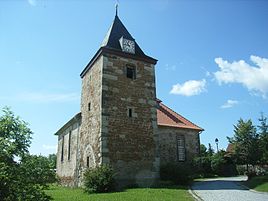Rehestädt
|
Rehestädt
Municipality of Wachsenburg
Coordinates: 50 ° 52 ′ 11 ″ N , 10 ° 55 ′ 25 ″ E
|
|
|---|---|
| Height : | 265 (258–282) m above sea level NHN |
| Residents : | 148 (December 31, 2010) |
| Incorporation : | March 8, 1994 |
| Incorporated into: | Ichtershausen |
| Postal code : | 99334 |
| Primaries : | 03628, 036202 |
|
St. Gangolf village church ( location → )
|
|
Rehestädt is a district of the municipality of Amt Wachsenburg in the Ilm district ( Thuringia ).
geography
Rehestädt is located at the transition from the foothills of the Thuringian Forest to the Thuringian Basin , about 270 meters above sea level, four kilometers northwest of Arnstadt .
history
It is believed that the place was founded by a man named Recheo . In 1191 there was already a developed village. As early as 1257, the Ichtershausen monastery acquired land in Rehestädt. By the end of the monastery Ichtershausen 1525 in the German Peasants' War was Rehstedt its property. In 1640, during the Thirty Years' War , only a third of the houses were still inhabited due to the death and flight of the inhabitants. The place belonged in the following time to the office Wachsenburg with Ichtershausen , which 1640 to the Duchy of Saxe-Gotha , from 1672 to the Duchy of Saxe-Gotha-Altenburg and in 1826 to the Duchy of Saxe-Coburg and Gotha .
Until 1920 Rehestädt belonged to Saxe-Coburg and Gotha, then to the district of Arnstadt or its successors. On March 8, 1994, the place was incorporated into the community of Ichtershausen. Since the merger of the municipality of Ichtershausen with the Wachsenburg municipality on January 1, 2013, Rehestädt has been part of the municipality of Wachsenburg.
In April 1945 the place was occupied by US troops and handed over to the Red Army in early July 1945 . This made him part of the Soviet Zone and the GDR . This brought with it the forced collectivization and later industrialization of agriculture.
Attractions
- In 1498 the church of St. Gangolf was built. In 1719 a new building took place, during the excavation work a grave with coins from 1242 or before was found. It is the most historic building in the village. The church received a new organ in 1750, which the organ builder Johann Christoph Thielemann had started. After he fell ill and was unable to complete the work, his student Johann Stephan Schmaltz from Arnstadt took over the job . The church was renovated between 2000 and 2003 by prisoners from the open penal system of the Ichtershausen juvenile detention center under the leadership of the construction hut of the New Ichtershausen Monastery .
- There are some restored half-timbered buildings in the village, and the Veste Behfeld farm with its residential building, farm buildings and a beautiful archway is particularly well preserved .
- A war memorial in the center of the town under a stately oak tree commemorates 6 fallen and missing persons from the First and 18 from the Second World War.
Economy and Transport
Rehestädt is an agricultural place. The Agroland agricultural eG Thörey / Rehestädt , emerged from a LPG, operates agriculture and a photovoltaic park. The facility is located on the northern outskirts of Rehestädt.
About one kilometer northeast of Rehestädt, on the outskirts of Thörey , the largest industrial park in the Ilm district has been located since the 1990s, which was developed and named after it, especially because of its location on the Erfurter Kreuz ( A 4 , A 71 ).
An area of several hectares on the northwestern edge of the town was used as a garbage dump for the Arnstadt district and the northern Ilm district from the 1970s to 2005 . These include the high mountains of landfills known as “old bodies” and “new bodies” as well as two hazardous waste sites. Part of the waste is now slowly being removed and incinerated in Leuna .
To 5.1 hectares, on the slope of the list Mountain (300 m), was commissioned by the residual waste treatment Mittelthüringen (CRMs) by Beck Energy a large solar plant for generating electrical energy with a nominal output of 444 kW p built and inaugurated in June of 2008. It has been on the grid since October 2008, is expected to generate 455,000 kWh / year and would thus bring the operator 164,000 euros / year in feed-in fees, which are guaranteed by the Renewable Energy Sources Act .
Roads lead from Rehestädt to Arnstadt , Thörey and Haarhausen . The nearest train station is one kilometer west of the town in Haarhausen on the Neudietendorf – Ritschenhausen railway line .
A cycle path from the direction of Thörey / industrial area leads up to near Rehestädt. It was created including the renaturation of the Riethgraben south of the industrial park as a compensation measure for its land consumption .
Personalities
- Hugo Gräf (born October 10, 1892 in Rehestädt; † October 23, 1958 in Gotha), politician (KPD, SED)
Web links
Individual evidence
- ^ Galetti: History and Description of the Duchy of Gotha , Volume 3, p. 345
- ↑ Municipalities 1994 and their changes since January 1, 1948 in the new federal states , Metzler-Poeschel publishing house, Stuttgart, 1995, ISBN 3-8246-0321-7 , publisher: Federal Statistical Office
- ↑ Prisoners renovate the church in Rehestädt , press release of the Evangelical Lutheran Church in Thuringia from July 12, 2003 ( memento of the original from September 27, 2007 in the Internet Archive ) Info: The archive link was automatically inserted and not yet checked. Please check the original and archive link according to the instructions and then remove this notice.
